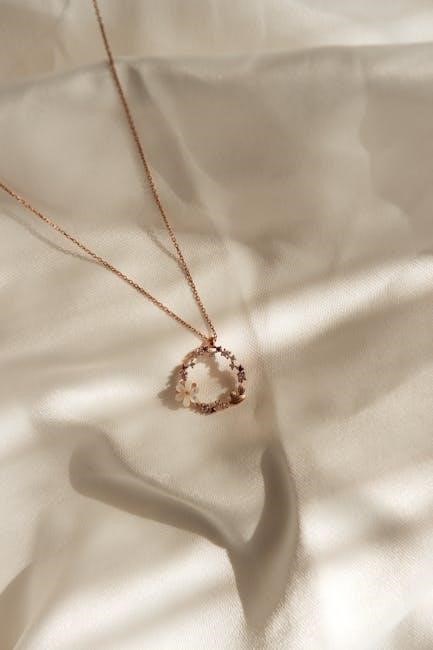The Byzantine chain is a stunning, rope-like chainmail design known for its intricate yet simple weave pattern, making it a popular choice in modern jewelry crafting․
What is a Byzantine Chain?
A Byzantine chain is a type of chainmail jewelry characterized by its intricate 4-in-1 box pattern, where each unit consists of four interconnected jump rings․ Known for its durability and flexibility, it creates a sleek, rope-like appearance․ Despite its name, it has no historical ties to the Byzantine Empire but remains a popular choice for jewelry makers due to its timeless appeal and relatively simple construction compared to other chainmail weaves․
Origins and Historical Background
The Byzantine chain, despite its name, does not originate from the Byzantine Empire․ Its true origins are unclear, but it is believed to be a modern design inspired by ancient chainmail patterns․ The term “Byzantine” was likely coined for its resemblance to intricate historical designs․ This weave has gained popularity in contemporary jewelry making for its elegant, rope-like appearance and versatility․ It is now a staple in chainmail jewelry, with its origins tracing back to early 20th-century craftsmanship․
Popularity in Modern Jewelry Making
The Byzantine chain has become a favorite in modern jewelry making due to its timeless appeal and versatility․ Its intricate yet simple weave pattern allows for both delicate and bold designs, making it suitable for necklaces, bracelets, and earrings․ Jewelry artisans appreciate its adaptability to various materials and gauges, enabling customization to fit different styles․ The chain’s rope-like texture adds a sophisticated touch, contributing to its widespread use in contemporary jewelry designs․ Its ease of learning also attracts both beginners and experienced crafters․
Materials and Supplies Needed
Jump rings in various gauges (14-20) and inner diameters, chain nose or flat nose pliers, and optional tools like wire cutters and work surfaces are essential․
Jump Rings: Sizes and Gauges

Jump rings for Byzantine chains come in various sizes and gauges, with common options including 14-gauge (7․94mm), 16-gauge (6․35mm), 18-gauge (4․76mm), and 20-gauge (3․17mm)․ The gauge refers to the wire thickness, with lower gauges being thicker and more durable․ Inner diameters also vary, ranging from 3․17mm to 7․94mm․ Choosing the right size and gauge depends on the desired look and durability of the chain․ Proper aspect ratios are crucial to ensure the weave lies smoothly and maintains its structural integrity․
Pliers: Types and Uses
Chain nose or flat nose pliers are essential for crafting Byzantine chains․ They are used to grip, open, and close jump rings securely without damaging them․ Smooth-faced pliers are recommended to avoid scratching the rings; Two pairs of pliers are often employed: one to hold the ring steady and the other to manipulate it․ This dual use allows for precise control, ensuring rings are properly aligned and closed flush․ Proper tool handling is key to achieving a polished and professional finish in the chain․
Other Essential Tools
Beyond pliers, essential tools for crafting a Byzantine chain include wire cutters for trimming excess wire, a mandrel for shaping, and a sturdy work surface․ A task light or magnifying glass can improve visibility, especially for intricate details․ Optional tools like a ring clamp or bench block can aid in holding pieces steady․ Organizing supplies, such as small bowls or trays for jump rings, helps streamline the process․ A clean, well-lit workspace is crucial for efficiency and precision in creating this intricate design․

Basic Steps to Get Started
Begin by preparing jump rings, ensuring they are properly closed and organized․ Understand the weave pattern, starting with basic units like the Box Chain 4-in-1․ Set up your workspace with pliers, wire cutters, and a clean surface․ Practice gripping and flipping rings to maintain the pattern’s flow․ Keep supplies like jump rings and tools within easy reach to streamline the process and ensure a smooth, efficient start to crafting your Byzantine chain design․
Preparing Jump Rings
Start by closing two jump rings securely using chain nose pliers, ensuring the joins are flush․ Open approximately 70 jump rings for a standard chain length․ Organize them into piles for easy access․ This preparation ensures efficiency and avoids interruption while weaving․ Properly prepared rings are essential for maintaining the Byzantine pattern’s integrity and achieving a professional finish․ Always check each ring for smooth movement and proper closure before beginning the weave․
Understanding the Weave Pattern
The Byzantine weave consists of interconnected jump rings arranged in a specific sequence․ Each unit is formed by threading rings through others, creating a rope-like texture․ The pattern alternates direction with each added ring, ensuring a balanced and visually appealing design․ This weave is fundamental for creating fluid, flexible chains․ Mastery of the sequence is key to maintaining the chain’s structural integrity and aesthetic appeal․ The Byzantine pattern is versatile and works well for both delicate and bold jewelry pieces․
Setting Up Your Workspace
A well-organized workspace is crucial for creating a Byzantine chain․ Start by laying out your tools, including chain nose pliers, flat nose pliers, and a work surface․ Keep jump rings sorted by size and gauge to avoid confusion․ Use a small container to hold open rings, preventing them from getting lost․ A lap tray or bead mat can help keep your work area tidy․ Proper lighting ensures visibility for intricate details․ Organize your supplies to streamline the weaving process and maintain efficiency․

Step-by-Step Instructions
Begin with two closed jump rings, using chain nose pliers to ensure they’re flush․ Start the weave by threading a new ring through both, maintaining the aspect ratio for a balanced pattern․
Starting the Chain
To begin, close two jump rings securely using chain nose pliers, ensuring the joins are flush for a seamless start․ Open a new jump ring and thread it through both closed rings, pulling gently to form the initial unit․ This step establishes the foundation of the Byzantine weave․ Properly aligning the rings is crucial for maintaining the chain’s balance and aesthetic appeal․ Start with four closed rings on two open ones to create the base pattern, ensuring the aspect ratio remains consistent for a professional finish․
Adding Rings to the Chain
To add rings, thread a new jump ring through two existing rings in the chain․ Close it securely with pliers, ensuring it lies flat․ Repeat this process, alternating sides to maintain the weave’s balance․ Use two pairs of pliers to grip and position rings precisely․ Keep the aspect ratio consistent for a polished look․ As you progress, organize rings in piles to streamline the process․ This step-by-step addition forms the chain’s length while preserving its intricate, interconnected design․
Gripping and Positioning Rings
Use smooth-faced or flat-nose pliers to grip rings firmly without scratching them․ Hold the chain steady, ensuring each new ring aligns properly with the existing weave․ Position rings so they lie flat and even, maintaining consistent tension․ Use a gentle but firm grip to avoid bending the rings out of shape․ Keep the chain taut but not overly tight to preserve the Byzantine pattern’s balance․ Proper positioning ensures a smooth, professional finish and prevents distortion in the design․
Flipping Rings for Pattern Continuation
Flipping rings is essential for maintaining the Byzantine pattern’s continuity․ Use two pairs of pliers to grip a ring firmly, ensuring it’s secure․ Twist the ring 180 degrees to reverse its position, allowing the chain to extend smoothly․ This step ensures the weave progresses evenly and maintains its structural integrity․ Keep the tension consistent to avoid loosening the design․ Practice this technique to master the seamless pattern continuation, ensuring the chain remains fluid and visually appealing throughout its length․
Completing the Chain
To complete the Byzantine chain, ensure the last jump ring is securely closed, maintaining the pattern’s consistency․ Inspect the entire chain for uniform tension and flatness․ Use pliers to gently adjust any rings that appear too tight or misaligned․ Once satisfied, the chain should lie smoothly and evenly․ This final step ensures the chain’s structural integrity and aesthetic appeal, preparing it for attaching a clasp or integrating into a larger design․ Proper completion ensures durability and a professional finish․
Adding a Clasp

Select a sturdy clasp that complements the chain’s design․ Attach it securely to both ends, ensuring a snug fit to prevent accidental opening and enhance durability․
Choosing the Right Clasp
Selecting the appropriate clasp is crucial for both functionality and aesthetics․ Opt for a durable option like a lobster claw or toggle clasp to ensure secure closure․ Consider the chain’s thickness and material to match the clasp’s size and finish․ A well-chosen clasp enhances the overall design while providing reliability, making it essential to balance style with practicality for a polished finish․
Attaching the Clasp
To securely attach the clasp, open a jump ring using two pairs of pliers․ Thread one end through the final ring of the Byzantine chain and the clasp’s loop․ Gently close the jump ring, ensuring it is flush and secure․ Repeat the process for the other end of the chain, ensuring a sturdy connection․ This method prevents the clasp from coming loose, providing a reliable and durable finish to your handmade jewelry piece․

Troubleshooting Common Mistakes
Common errors include misaligned rings and improper tension․ Check each connection for tightness and alignment․ Adjusting the aspect ratio can fix looseness or tightness issues effectively․
Identifying and Fixing Errors
Identifying errors in a Byzantine chain involves checking for misaligned or improperly closed rings․ If a ring is not closed securely, it can cause the entire chain to unravel․ To fix, carefully reopen the faulty ring with pliers, ensuring it is closed tightly․ Regular inspection during the weaving process helps catch mistakes early, preventing major issues later․ Proper tools and attention to detail are key to maintaining the integrity of the weave․ Consistency in ring tension is also crucial for a professional finish․

Adjusting the Aspect Ratio
The aspect ratio in a Byzantine chain refers to the relationship between the jump ring’s inner diameter and its wire gauge․ Maintaining an ideal range (3․2 to 4․2) ensures the chain lies smoothly and maintains its pattern․ If the ratio is off, the chain may appear too loose or tight․ To adjust, use smaller or larger rings to achieve balance․ Proper aspect ratio ensures the weave flows seamlessly and maintains a professional finish․ Consistency is key for a polished and visually appealing chain․
Advanced Techniques

Elevate your Byzantine chain designs with advanced techniques such as creating a graduated chain and experimenting with different materials and colors for unique, eye-catching pieces․

Creating a Graduated Chain
To create a graduated Byzantine chain, start by organizing jump rings in varying sizes․ Begin with larger rings and gradually transition to smaller ones for a dynamic look․ Use a size chart to ensure proper gauge and inner diameter ratios․ Thread the rings according to the Byzantine weave pattern, flipping and positioning them to maintain the chain’s flow․ This technique adds visual interest and showcases mastery of the weave․ Experiment with materials and colors for unique designs․
Using Different Materials and Colors
Enhance your Byzantine chain by experimenting with various materials like silver, gold, and colored jump rings․ Mix metals for a modern aesthetic or incorporate vibrant hues for a bold statement․ Alternate between different gauges and inner diameters to add texture․ Thread contrasting colors through the weave to create intricate patterns․ This versatility allows for personalized designs, making each piece unique and visually striking․ Explore combinations to reflect your artistic vision and elevate your jewelry creations․
Congratulations! You’ve mastered the Byzantine chain technique․ Continue practicing to refine your skills and explore new designs․ Experiment with materials and colors to create unique jewelry pieces․
Practicing and Mastering the Weave
Consistent practice is key to mastering the Byzantine chain․ Begin with short chains to build muscle memory and precision․ Focus on maintaining uniform tension and alignment of the rings;
Start with larger jump rings for easier handling, then gradually transition to smaller gauges as your skills improve․ Pay attention to the aspect ratio to ensure a balanced and visually appealing design․ Patience and repetition will refine your technique, allowing you to create intricate and professional-looking jewelry pieces with confidence․
Exploring Further Designs
Once comfortable with the Byzantine weave, explore advanced designs by incorporating graduated ring sizes or mixing materials and colors for unique effects․ Experiment with pattern variations, such as alternating ring orientations or adding decorative connectors․ Consider integrating pendants or beads to create focal points․ The Byzantine chain’s versatility allows for endless creativity, from delicate bracelets to bold necklaces․ Push your skills by experimenting with complex weaves or combining it with other chain styles to craft truly personalized jewelry pieces․